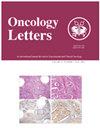Smad泛素化调节因子2对甲状腺乳头状癌的抑癌作用
IF 2.2
4区 医学
Q3 ONCOLOGY
引用次数: 0
摘要
Smad泛素化调节因子2(SMURF2)作为E6AP羧基末端型E3泛素连接酶的同源物,具有调节细胞周期进展和肿瘤生长因子表达的功能。研究发现,SMURF2 在多种癌症中发挥着肿瘤抑制因子的作用;然而,它在甲状腺乳头状癌(PTC)中的功能在很大程度上仍不为人所知。因此,本研究旨在探讨 SMURF2 在 PTC 中的功能。本研究采用逆转录-定量 PCR 和 Western 印迹技术检测 SMURF2 在体外的细胞表达。在增加或抑制 SMURF2 的表达后,用 MTT 检测对肿瘤细胞增殖的影响,用 Transwell 检测对肿瘤细胞迁移和侵袭的影响。最后,用 ELISA 检测对肿瘤细胞葡萄糖和谷氨酰胺代谢的影响,结果发现 SMURF2 在 PTC 组织中被下调。此外,SMURF2 还能抑制 PTC 细胞的增殖、侵袭和迁移,并促进其凋亡。最后,SMURF2抑制细胞糖酵解和谷氨酰胺酵解,影响PTC细胞株TPC-1的新陈代谢。因此,本研究的结果表明,SMURF2 可能是治疗 PTC 的潜在靶点。本文章由计算机程序翻译,如有差异,请以英文原文为准。
Tumor‑suppressive effects of Smad‑ubiquitination regulator 2 in papillary thyroid carcinoma.
Smad-ubiquitination regulator 2 (SMURF2) functions as a homolog of E6AP carboxyl terminus-type E3 ubiquitin ligase to regulate cell cycle progression and tumor growth factor expression. SMURF2 has been revealed to function as a tumor suppressor in a number of cancers; however, its function in papillary thyroid carcinoma (PTC) remains largely unknown. Therefore, the aim of the present study was to investigate the function of SMURF2 in PTC. Reverse transcription-quantitative PCR and western blotting were used to detect cellular expression of SMURF2 in vitro. After increasing or inhibiting the expression of SMURF2, MTT was used to detect the effect on tumor cell proliferation and Transwell assays were used to detect the effect on tumor cell migration and invasion. Finally, ELISA was used to detect the effects on glucose and glutamine metabolism in tumor cells and the findings revealed that SMURF2 was downregulated in PTC tissues. Moreover, SMURF2 inhibited the proliferation, invasion and migration of PTC cells, and promoted their apoptosis. Finally, SMURF2 inhibited cell glycolysis and glutaminolysis and affected metabolism in the PTC cell line, TPC-1. Thus, the findings of the present study suggest that SMURF2 may be a potential target in the treatment of PTC.
求助全文
通过发布文献求助,成功后即可免费获取论文全文。
去求助
来源期刊

Oncology Letters
ONCOLOGY-
CiteScore
5.70
自引率
0.00%
发文量
412
审稿时长
2.0 months
期刊介绍:
Oncology Letters is a monthly, peer-reviewed journal, available in print and online, that focuses on all aspects of clinical oncology, as well as in vitro and in vivo experimental model systems relevant to the mechanisms of disease.
The principal aim of Oncology Letters is to provide the prompt publication of original studies of high quality that pertain to clinical oncology, chemotherapy, oncogenes, carcinogenesis, metastasis, epidemiology and viral oncology in the form of original research, reviews and case reports.
 求助内容:
求助内容: 应助结果提醒方式:
应助结果提醒方式:


